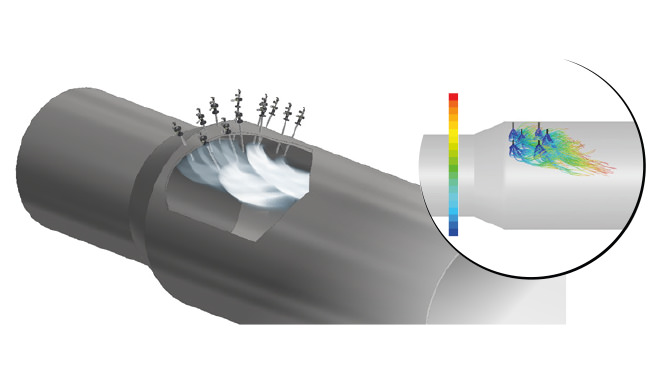SteamMax Nozzles and Injectors Help Petrochemical Producer Increase Efficiency
SteamMax Nozzles and Injectors Help Petrochemical Producer Increase Efficiency
A petrochemical producer wanted to increase production but one of the limitations was the capacity of the spray injectors installed in its thermal oxidizer. Learn how they improved production efficiency resulting in a 15-day payback period.
Problem:
Saudi International Petrochemical Co. (SIPCHEM), a Middle Eastern petrochemical producer, wanted to increase production but one of the limitations was the capacity of the spray injectors installed in its thermal oxidizer. Waste acid, a normal by-product of SIPCHEM’s manufacturing processes, is burned off by spraying it into the thermal oxidizer’s combustion chamber.
The previously used spray injectors could not support the desired production increase. The nozzles were not designed for use with steam as the atomizing medium and atomization was poor. This affected the combustion reaction and led to higher emissions at times. In addition, to protect the nozzles from the high operating temperatures (over 900°C/1650°F) in the thermal oxidizer, the injectors barely protruded into the combustion chamber inside of the refractory-lined oxidizer shell. As a result of this positioning, waste acid was being sprayed on the surface between the refractory and the shell, creating large holes in the thermal oxidizer shell and causing the refractory material to fall inside the oxidizer.

Solution:
Twelve steam-jacketed injectors with SteamMax SM 10B nozzles were installed as part of a complete overhaul of the thermal oxidizer. The SteamMax nozzles, designed specifically for use with steam, are made of 310 stainless steel to withstand the high temperatures in the thermal oxidizer, providing flexibility for optimal placement. Using computational fluid dynamics (CFD) modeling, Spraying Systems Co. determined the optimum number, placement and orientation of the injectors. The new arrangement consists of six staggered pairs of injectors that project 13.4 inches (340 mm) into the combustion chamber and provide full droplet vaporization with minimal wall contact.
Results:
SIPCHEM has been able to process 35% more acid with no performance problems and downtime has been reduced by 6%. In addition, steam consumption used for atomization has been reduced by 20%. The improved production efficiency resulted in a 15-day payback period.
For complete details of this case study click here to see the PDF version.

